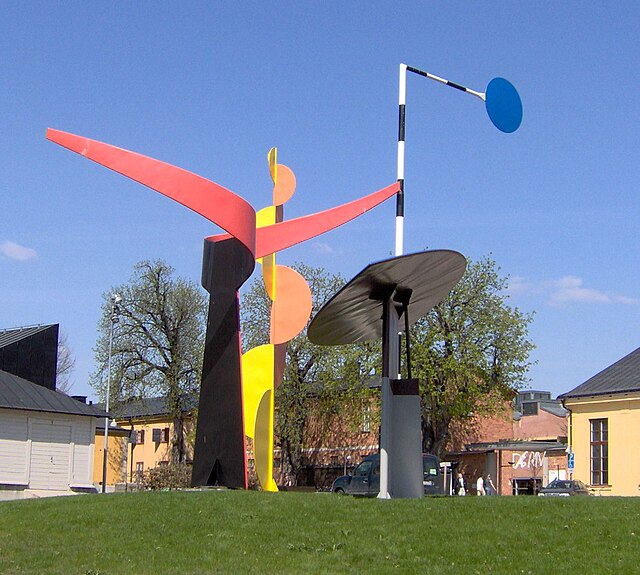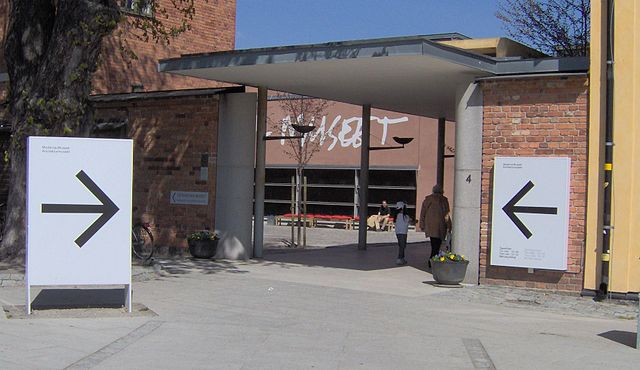Moderna Museet
Art museum in Stockholm, Sweden From Wikipedia, the free encyclopedia
Moderna Museet is a state museum for modern and contemporary art located on the island of Skeppsholmen in central Stockholm, opened in 1958. In 2009, the museum opened Moderna Museet Malmö in Malmö.
 | |
 | |
| Established | 1958 |
|---|---|
| Location | Skeppsholmen, Stockholm, Sweden |
| Type | Art museum |
| Collection size |
|
| Director | Gitte Ørskou |
| Public transit access | Bus to Arkitektur-/Moderna museet |
| Website | www |





History
The museum opened in Stockholm on 9 May 1958,[2] and opened a branch in Malmö in 2009, in a building that had housed the Rooseum centre for contemporary art.[3]
Collection
Summarize
Perspective
The museum houses Swedish and international modern and contemporary art, including pieces by Pablo Picasso and Salvador Dalí, and a model of Tatlin's Tower. The museum's collection also includes key works by artists such as Marcel Duchamp, Louise Bourgeois, Niki de Saint Phalle, Henri Matisse and Robert Rauschenberg, as well as ongoing acquisitions by contemporary artists.[1]
On 8 November 1993, six works by Picasso and two by Georges Braque, totaling more than £40 million, were stolen from the museum in a coup in which the burglars came in through the roof by night, copying a method from the 1955 French film Rififi.[4] All six of the Picasso paintings and one of the Braque paintings have been recovered.[5]
Pontus Hultén Collection
In 2005, former museum director Pontus Hultén bequeathed over 700 works of art to Moderna Museet, along with his archive and library. A few works of the collection are on display with the museum's permanent collection; many others are exhibited in the purpose-built Pontus Hultén Study Gallery.[6]
Sculpture park
The museum has a sculpture park on the island with works by sculptors of diverse nationalities.[7]
- The Four Elements, Alexander Calder, 1961
- Le Paradis fantastique, Jean Tinguely and Niki de Saint Phalle, 1966
- Déjeuner sur l'herbe, Pablo Picasso and Carl Nesjar, 1962
- Monumentalfigur, Christian Berg, 1927
- Monument över den sista cigaretten, Erik Dietman, 1975
- Lenin Monument April 13th 1917, Björn Lövin, 1977
- Mannen på templet, Bjørn Nørgaard, 1980
- Svart svensk granit, Ulrich Rückriem, 1981
- Pavilion Sculpture II, Dan Graham, 1984
- Louisa, Thomas M. Woodruff, 1987
- Freedom and Belief (their own affair), Joseph Kosuth, 1998
- No title, Per Kirkeby, 1999–2000
- Instabil, Lars Englund, 2005
- Närkontakt, Gustav Kraitz, 2008
Architecture
The museum was initially housed in Exercishuset on Skeppsholmen.[2]
From 1994 to 1998, it was temporarily moved to another location, the Spårvägshallarna,[8] in Stockholm while the new building on Skeppsholmen, designed by the Spanish architect Rafael Moneo, was built.[9] The Pontus Hultén Study Gallery was designed by Renzo Piano.
The museum shares its premises with the Swedish Centre for Architecture and Design.
Activity
The museum organizes and is a venue for temporary contemporary art exhibitions throughout the year. In 2005, the museum hosted the onedotzero festival with the intention of attracting a new, younger audience to the museum with screenings, installations, talks and live VJ audio-visual events.[10]
Directors
- 1958–1973: Pontus Hultén[6]
- 1973–1977: Philip von Schantz
- 1977–1979: Karin Lindegren
- 1980–1989: Olle Granath
- 1989–1995: Björn Springfeldt
- 1996–2001: David Elliott
- 2001–2010: Lars Nittve
- 2010–2018: Daniel Birnbaum[11]
- 2018–2019: Ann-Sofi Noring (acting)[12]
- Since 2019: Gitte Ørskou[12][13]
See also
References
External links
Wikiwand - on
Seamless Wikipedia browsing. On steroids.
